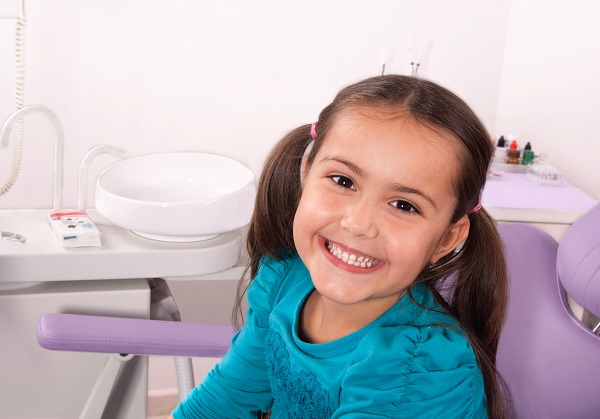Silver Diamine Fluoride for the Pediatric Dentistry Visit

It is common for cavities to be seen in patients in pediatric dentistry. However, many children may have trouble sitting still for filling procedures and some parents may have concerns that their child is too young. Fortunately there are other options. Here is an explanation about silver diamine fluoride, what the application procedure involves and how it helps pediatric patients who have cavities.
What is silver diamine fluoride?
SDF is a noninvasive and inexpensive topical medication that is used to treat dental cavities by stopping decay and preventing the cavity from progressing. This is beneficial to quickly end the unpleasant symptoms associated with cavities, such as tooth pain and sensitivity, without going through an invasive procedure.
It is a helpful treatment option for young children who may have trouble sitting still for prolonged periods of time, as well as those who suffer from anxiety. Children who have physical or mental disabilities are also great candidates. SDF is especially beneficial for young children who have a cavity in a baby tooth because it protects the tooth from further decay but means pediatric patients can avoid going through an invasive procedure on a tooth that will eventually fall out.
SDF is unable to restore teeth, so it should never be used on a broken tooth. Silver diamine fluoride should not be used on a patient who needs a procedure such as a root canal or a patient with an extremely deep cavity. Patients who have an infection in their mouth should also not use SDF.
Is it safe?
Silver diamine fluoride is safe for young children, including toddlers. It has been used in pediatric dentistry for many years and is FDA approved. However, it cannot be used in children with a silver allergy as silver is used in SDF.
What are the ingredients in SDF?
Silver diamine fluoride is comprised of only a few key ingredients:
- Fluoride: This ingredient is necessary to help strengthen the tooth and remineralize it. This helps to stop tooth decay and prevent further decay.
- Ammonia: For maximum effectiveness, ammonia is needed to keep the solution concentrated.
- Silver: This ingredient has anti-microbial properties and is essential to help kill bacteria in the tooth.
How is SDF applied?
Gauze or cotton is used around the tooth to keep saliva from touching it so the treatment can work properly. The surface of the tooth and surrounding teeth are suctioned to remove all moisture. Then the silver diamine fluoride is brushed onto the tooth for a few minutes to ensure it gets deep into the tooth and reaches the cavity.
Patients will need to avoid eating or drinking for an hour following the procedure. SDF may need multiple applications.
Conclusion
Silver diamine fluoride is an effective alternative for cavities in pediatric dentistry. This procedure is inexpensive and is a wonderful option for children who are young or those who have dental anxieties, as well as children who have disabilities.
Request an appointment here: https://www.grandparkwaypediatricdental.com or call Grand Parkway Pediatric Dental at (832) 579-0960 for an appointment in our Richmond office.
Check out what others are saying about our services on Yelp: Read our Yelp reviews.
Recent Posts
Composite fillings, especially newer ones, are strong and durable but can wear out over time. The excess pressure from grinding teeth can cause them to wear out more quickly. In addition, poor dental hygiene may contribute to decay, compromising fillings. A loose filling is not a dental emergency but requires attention as soon as possible…
A bright and healthy smile is an important part of a child's oral and social development. However, parents may wonder if teeth whitening for kids is a safe and gentle treatment option to improve the appearance of their little one's teeth. While adults have many whitening options, there is some caution that parents should take…
Kids dentist practices are key to establishing a positive outlook on dental care, especially when guiding children through the early stages of oral health. Finding the right provider can transform what might otherwise feel like a stressful appointment into a comfortable, beneficial experience. Pediatric dentistry involves more than fixing cavities; it focuses on teaching proper…
Dental fillings can consist of composite (tooth-colored), porcelain, metal, and more. Pediatric dentists use traditional and tooth-colored fillings to close small holes in the teeth, commonly caused by cavities (extremely common in children). The dentist will extract decayed tissues and replace them with one of these filling materials. Dental fillings usually last many years before…


